Crypto Academy Season 3 Beginners' course - Task 1: STEEM & TRON
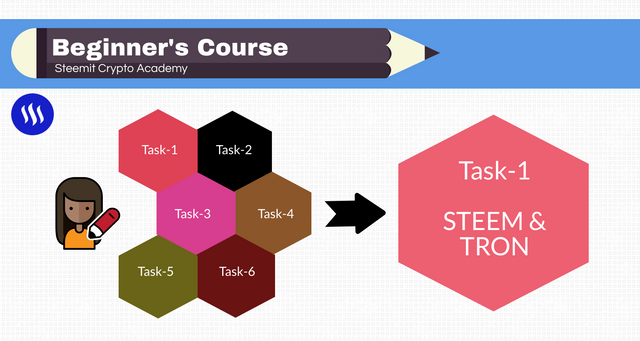


Steem is an open-source social Blockchain protocol where the communities thrive, an ecosystem of social blogging empowered with immutable content, which enables users to monetize content with Proof-of-Brain. The federated peer-to-peer interaction became a reality in the year 2016 with the introduction of dApp Steemit Inc(the first-ever dApp) on the top of Steem Blockchain.
Governance
The governance protocol adopted in Steem Blockchain is DPoS(Delegated Proof of Stake) with (20+1) witnesses responsible to create, sign the transactions, and secure the network. The Block producing time is 3 seconds. The Block production is done in rounds and each round is of 63 seconds.
In PoW chains, the beneficiary of a Block reward is a miner and they are all randomly selected.
In DPoS, it is definite, not random. The top (20) witnesses plus one backup witness receive Block rewards, 10% of the total reward pool(inflationary model).
The witnesses are elected based on the community voting.

Reward Pool
There is a pool in Steem Blockchain in which the newly minted tokens are being accumulated at a certain fixed rate as per the inflation rate every 3 seconds.
The current inflation rate is somewhere below 8%. And inflation rate decreases at a rate of 0.01% every 250,000 Blocks until it becomes 0.95%.
The newly minted tokens collected in the pool are known as Reward Pool.
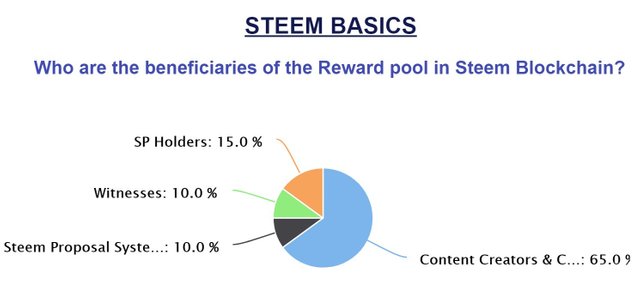
The beneficiary of the Reward Pool are:-
- Content Creaters & Curators(PoB)- 65%
- Witnesses- 10%
- Vested Tokens Holders(SP Holders)- 15%
- Steem DAO- 10%
The PoB reward pool is Task-Based and tasks are--
- Publishing Content
- Engaging with the Content & Curating it, helping in Content Discovery.

Proof-of-Brain
There is a Reward Pool as discussed above.
There is also a stake-weighted mechanism(SP) to allow users to distribute(upvote) or redistribute(downvote) rewards from the Reward Pool. More the SP more is the influence power to distribute/redistribute rewards.

Being a Blockchain-based social media, it is fundamentally decentralized, empowered by the wisdom of the people(the independent insights) to determine good/bad content.
The reward pool(65% of the total), the stake-weighted mechanism(SP), the wisdom of the people, all put together is known as Poof-of-Brain(PoB).

Upvote & Downvote, General Voting Window
When you exercise the stake-weighted influence power, you will find there are two buttons in every post: Upvote & Downvote.

Upvote- If you hit the upvote button it will distribute the reward, and a certain amount will appear in the post payout subject to the stake weight(SP) and voting weight. So the reward will flow from the reward pool to the post being upvoted.
Downvote- If you hit the downvote button, the reward will go back to the pool, how much reward from the post payout will go back to the bool depends upon the influence power of the downvoter(stake weight(SP) & voting weight).

Put simply, Upvote is the process of distributing the rewards and downvote is the process of redistributing the rewards. Being a decentralized ecosystem, everyone is free to decide how to distribute and how to redistribute, subject to their influence power.
Note- Upvote earns curation reward while downvote does not earn a curation reward.
General Voting Window
Steem Blockchain rewards the content creators and curators at 7 days age of a post. In other words, the post payout matures at 7 days. During these 7 days, the post receives upvotes (or downvotes if any) and the net amount of a post payout is then distributed among the author and curator(s) in a ratio of 50%/50%.
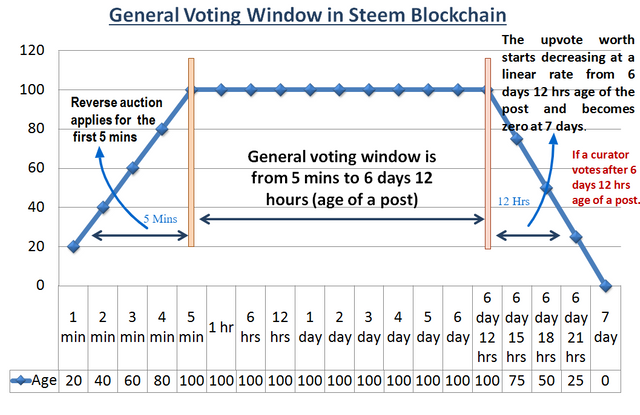.png)
Of the 7 days, the first 5mins of the post from the time of publishing in Steem Blockchain is known as Reverse Auction, in which a linear discount of curation reward applies.
So if you vote during the first five mins age of a post, you lose a certain percentage of curation reward(linear discount from 0 min to 5 mins age of a post, with 100% discount at (0 secs) and 0% discount at 5 mins(300 secs) age of a post). The lost curation reward returns to the reward pool.
Similarly, if you are voting after 6 Days 12 hrs age of a post, then your voting worth starts depleting at a linear rate with 0% depletion at 6 days 12 hrs and 100% depletion at 7 days the age of a post. Here the upvote worth depletes if you vote beyond 6 days 12 hrs age of a post.
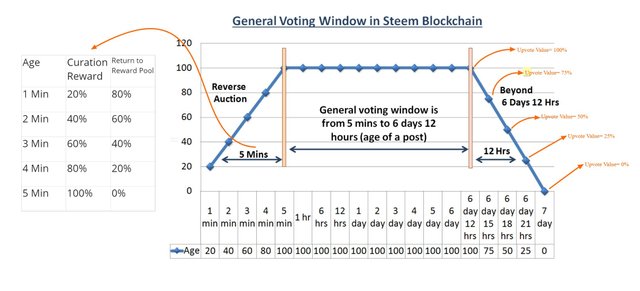.png)
In other words, the same resource(same SP, same Voting weight) does not produce the same result(upvote value) if you vote outside 6 Days 12 Hrs age of a post and it becomes zero at 7 Days. After 7 days, it won't produce any monetary value upon voting, hence it won't consume VP.
Put simply, the general voting window is considered as "5 mins to 6 days 12 hrs age" of a post.

Voting Mana, & its depletion, Recharge
Upvoting & Downvoting consume Voting Mana & Downvote Mana respectively. Voting mana and Downvote further depends on the amount of SP.
The voting mana pool is 4 times larger than the Downvote mana.

The journey always starts from 100% for both the mana pool and depending on the usage it depletes.
Depletion
If you upvote a post with 100% weight, then it consumes 2% of the voting mana. If you downvote a post with 100% weight, it consumes 8% of the downvote mana, because voting mana is 4 times bigger than downvote mana.
Your upvote value at 100% weight is highest at 100% VP and as you go on voting, the upvote value diminishes in proportion to the depletion of VP.
VP- Voting Power or Voting Mana
Recharge
Both Voting mana and downvote mana regenerates at a fixed 20% per day.
Analysis
If you go on a voting spree, the depletion of voting mana will have a projection like this--
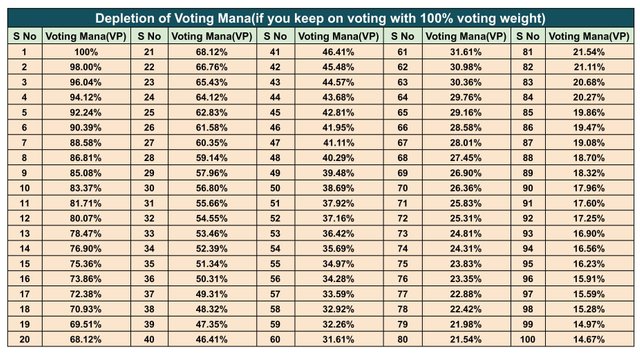
There is no such restriction in Steem Blockchain. So if you go on a voting spree, it will keep consuming voting mana(VP) and the limiting conditions will tend to 0%(it will never reach 0%, but it will tend to reach 0%), which may not be effective in generating monetary value.
Therefore it is always recommended to keep the voting mana above 80% for effective curation management(considering 20% recharge per day)
For SP above 500, a slider will appear when you upvote to allow you to adjust the voting weight. Below 500 SP will always consume 100% voting weight.


Post Payout-- STEEM, SBD, SP

When you upvote a post, a certain numerical figure appears, which is known as Post Payout, which matures at the end of 7 days age of a post. Both Authors & Curators are the beneficiaries of a post-payout.
A post payout is a combination of three different rewards-- STEEM, SBD, and SP.
For an author, it can be SBD+SP(if the Debt Ratio is below 9%; currently it is below 9%) or STEEM+SP(if the Debt Ratio is above 10%), or STEEM+SBD+SP(if the Debt ratio is between 9% and 10%)
Debt Ratio is defined as the ratio of SBD Market cap to STEEM Market cap.
The Curator Reward is always in SP whereas, in the case of Author Rewards, there are three options:-
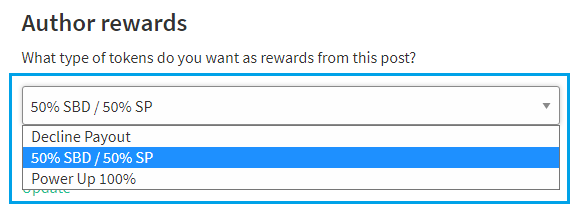
- 50% SBD/50% SP-- 50% in SBD & 50% in SP
- 100% Power Up-- entire reward in SP
- Decline Payout-- No reward
The default setting is always 50% SBD/50% SP.


Decline Payout means the author refuses to take any reward from the pool.
Note- Please do note that Author's SP gets converted from SBD(pegged to 1 USD) whereas the Curator's SP gets converted from USD. That is why the ideal designation of this unit is STEEM TOKEN UNIT(not $) which is a mix of SBD & USD.
This point may not be taken into account if SBD respects the peg of 1SBD= 1 USD every time, but it is not the case anymore, hence this Steem Token unit(STU) is the ideal designation for the post payout.
In the external market, SBD may value more than 1 USD, but Steem Blockchain always reads 1 SBD= 1 USD.

Curation- Convergent Linear Reward, isolated judgment & community judgment
What does curation mean in Steem Blockchain?
- Read a post.
- Diligently check the trustworthy source of the content
- Does it add value to your life; if yes, then do engage to further dissect & disseminate the information, you can also add your personal take.
- If the content happens to be plagirarized/spam content, then indicate that in the post and let the community know the existence of such harmful content.
- Independently determine how valuable/harmful the content is for Steem Blockchain.
- Upvote it (if you find it to be useful) using the available resources(SP, VP, Voting weight).
- Resteem the content to share it with your followers. Doing so will create a network effect.
All these put together is known as Curation. When a piece of content is curated by many such individuals it is called Curated content.
.jpg)
Content Discovery
Finding, collecting, and organizing all curated content, empowered with a stake-weighted mechanism(SP) gives rise to Content Discovery. The Better Content Discovery is pivotal to organizational interactions of both individuals & the community, how good the curators are to filter out the noise, how good they are to unanimously agree on the best/quality content.
Better content discovery literally means that the best/original/relevant content is voted to the top of the trending list. In other words, you reach an agreement with the community on quality content structurally, monetarily, qualitatively.
Convergent Linear Reward
The Reward Algorithm coded in the Steem Blockchain is Convergent Liner Reward, this also empowers the curators to reach an agreement on the brilliant content. Because when more people agree and approve the content, the reward curve tends to reach linearity. The more the number of curators, the better is the content discovery.
In convergent linear reward, for the lower values of input(SP), the output is much smaller. But with higher input values(SP), the output is much higher and started becoming linear.
.png)
If there are three curators-- A, B, C with SP values 10000 SP, 15,000 SP, and 20,000 SP respectively. If they all remain isolated in curation, then their reward will be less as individual curators. If all these three curators reach an agreement on quality content and curate as a community(the cumulative SP= 45000 SP) then they all earn a better curation reward.
The self-upvoted content, poor quality content, will always remain in the lower zone(or Sub-linear zone). The convergent linear reward encourages the users to visit other's posts and find quality content, in the quest for the quality content they also help in better content discovery. In return, they earn better curation rewards than isolated judgment.

Importance of Memo in Steem Blockchain
When you make a transfer(STEEM) to another peer, you might not need a memo, unless you are very specific to send a message.
But if you send it to an Exchange wallet, a Memo is essential to identify you. Please note that the Exchanges(Binance, Huobi, Poloniex, etc) run Exchange nodes and the deposit and withdrawal are automated. So when you create an account in an Exchange and make a deposit, it asks you to deposit to the specified Address along with the Memo.
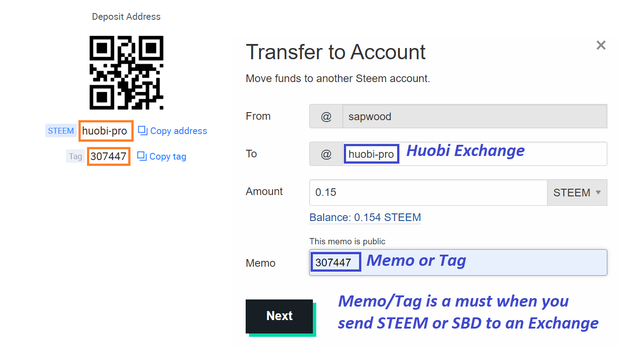
The Memo is like an identifier ID for the Exchange node and based on that it processes the deposit. For a withdrawal of STEEM from Exchange to your Steemitwallet you may not need a Memo, but if you are transferring from one Exchange to another, Memo is required(e.g. Binance to Huobi).

List of Exchanges (STEEM)
https://coinmarketcap.com/currencies/steem/markets/
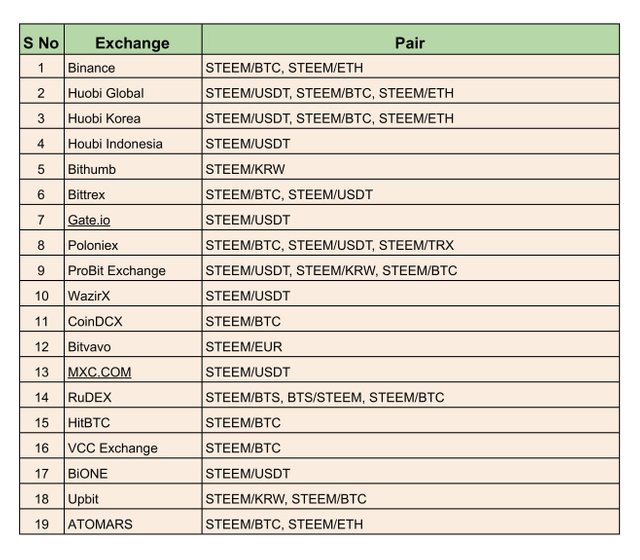-1.jpg)

Coinmarketcap
You can always check the Coinmarketcap and the subsequent rank of a coin by visiting https://coinmarketcap.com/

Coinmarketcap of a Coin= Circulating Supply * Price of the coin.
Steem Coinmarketcap= $ 135, 903, 607
Rank= 190

Resource Credits
Transaction of STEEM and/or operations(social activities and other non-monetary operations) does not cost you a fee. Yes, STEEM is a fee-less token. But every operation does consume resources. So Steem Blockchain does adopt a computational resource model. It is defined as Resource Credits in Steem Blockchain.
Resource Credit is directly proportional to SP size. More the SP more is the Resource Credits.
Resource credits comprise of--
- CPU
- State Memory
- History size
15 SP to 20 SP is enough to interact with Steem Blockchain without having to worry about "running short of Resource Credits". That is why all the newly created accounts in Steemit are delegated with 15 SP to allow users to get off to a smooth start.
Resource credit regenerates approx 20% per day. It is a non-transferable resource.

Vesting Schedule
The vesting schedule in Steem Blockchain is 4 weeks. In other words, the STEEM powered up as SP can be powered down at a rate of 1/4th per week.
Delegated SP can not be powered down. Any delegated SP has to be first undelegated, then it goes through a cooling-off period of 5 days before it reflects in your wallet, then the SP can be powered down.

Benefits of holding SP
SP is precisely an influence power. More the SP more is the influence. Further, the distribution of the reward pool is proportional to stake-weighted SP.
The reward mechanism always favors those who have higher SP and the long-term benefits of holding SP also adds to community building.
On top of it, with the TRX integration in Steemit Wallet, the Steem users also earn TRX reward for the social activities in Steem Blockchain in a 1SP:1TRX ratio.
What are the different rewards the users earn by holding SP:-
- Curation Reward(32.5% of the total reward pool), better influence power in distributing PoB reward pool
- Interests(Vested Token Holders earns 15% of the total reward pool)
- As curation reward is pivotal to SP size, better TRX reward [1 TRX for every SP earned(1 SP: 1 TRX)]
The non-monetary benefits(or indirect benefits)of holding SP includes:-
- Actively participate in Blockchain Governance
- Community Building
- Become an Influencer and hence earn a follower base


Tron is an open-source permissionless Blockchain that seeks to offer a cost-effective solution for smart contract platforms, ideally, an underlying Blockchain infrastructure where anyone can create a decentralized application, TRC standard tokens, Smart contracts, etc. It is similar to what Etherum offers, but with better scalability and almost no transaction fee, which is the cornerstone for widespread adoption of Blockchain and smart contract platform.
Tron ranks 25th in terms of Coinmarketcap.
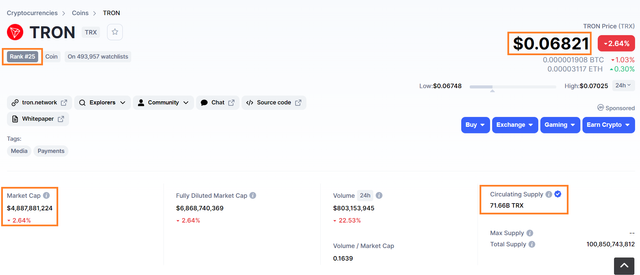

Governance
Tron Blockchain adopts DPoS consensus mechanism in which 27 Super representatives(SRs) are elected through community voting. The votes are counted every 6 hours and accordingly the top 27 candidates as SRs are elected who are responsible to secure and maintain the network.
Block producing time is 3 seconds and scaling capacity is 2000 transactions per second in Tron Blockchain.
TRX powered up is known as Tron Power(TP) and the unfreeze schedule is 3 days only. To vote for SRs one needs TP, after unfreezing Tron Power, the votes become invalid.

TRX, TRC10 & TRC20 Tokens
TRX is the native token of Tron Blockchain
TRC- Tron Request Comments
There are two standards of tokens-- TRC10 and TRC20
While both the standards include the functionalities of development processes, the creation of TRC10 tokens does not need Tron Virtual Machine, whereas TRC20 standard tokens are smart contract implementation and hence need Tron Virtual Machine.

Computational Resource Model
The resource model of Tron Blockchain comprises-- Bandwidth, CPU, Storage, RAM.
It is further conceptualized and categorized into two resource points-- Bandwidth & Energy.
- Bandwidth point represents Bandwidth
- Energy represents CPU & Storage.
Ordinary transfers consume Bandwith only whereas smart contract trigger consumes both bandwidth & energy.
Bandwidth points consumption= number of bytes of a transaction * Bandwidth point rate
Every account in Tron Blockchain has a free 5000 Bandwidth every 24 hrs. Any consumption/use is reset to zero at 24 hrs. In other words, you get a full 5000 Bandwith every day.
A user can also get additional Bandwidth & Energy by freezing TRX.
TRX & TRC10 Transfers consume Bandwidth only whereas TRC20 transfers consume both Bandwidth & Energy. Smart contract trigger transfers consume both Bandwidth and Energy.
Any shortfall of required Bandwidth/Energy is accommodated with the burning of TRX.

Steem Integrated Tron Wallet and 1SP: 1 TRX reward
Steemit Inc and Tron entered into a strategic partnership in Feb' 2020 and on 2nd December' 2020 Steem & TRX integration went live enabling users to earn TRX in a ratio of 1 TRX: 1 SP for the social activities performed in Steem Blockchain.
Please note that Tron and Steem are two different Blockchains, and the users in Steem earn TRX rewards(1 TRX: 1SP) alongside the defined rewards of Steem Blockchain.

List of Exchanges
https://coinmarketcap.com/currencies/tron/markets/
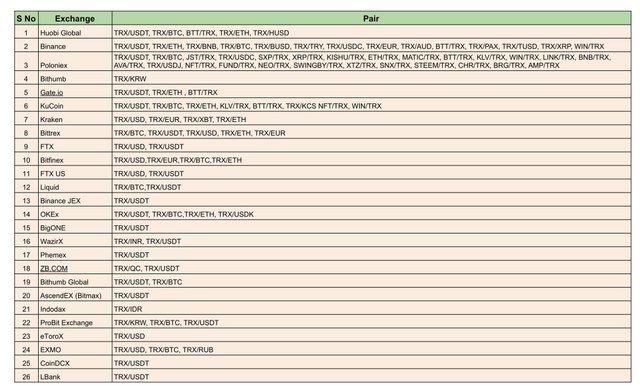

DApps
To explore the DApps in Tron Blockchain visit- https://www.dapp.com/dapps/tron, or dapp.review or dappradar.
Some of the popular DApps in Tron Blockchain-- Justswap, PoloniDEX, JustLend, Unifi Protocol, and many others.

Homework Task-1
(1) What is PoB? What does curation mean to you in Steem Blockchain? What are the benefits of building SP? How do you explain self-upvote as a good or bad social behavior & why? Explore Coinmarketcap.com to indicate rank, STEEM price, and coinmarketcap of STEEM(screenshot required)? What are the different tokens do you earn by socializing in Steem Blockchain?
(2) Explain the difference between [SP, STEEM, SBD] & [TRX, TRC10, TRC20 tokens](with examples)? Explore Coinmarketcap.com to indicate the rank, coinmarketcap, and circulating supply of STEEM and TRX? Which exchange are you familiar with where both STEEM and TRX are listed? Does it cost any fee for transacting STEEM and TRX? How important is the use of Memo while transferring STEEM from Steemitwallet to an Exchange wallet, do you essentially need a similar memo for transferring STEEM from Exchange wallet to your Steemit wallet?
(3) Difference between isolated judgment & Community judgment in Curation? What is the general voting window in Steem Blockchain? Please vote a post that is older than 7 days and tell us your experience, does it consume your VP, does it produce any monetary value? What is the difference between 50% SBD/50% SP payout and 100% power up? Suppose your VP is 90%, if you upvote with 100% voting weight, what will be the VP after voting?(Note-Before voting a post check the VP status in Steemworld.org, take a screenshot, and take another screenshot after voting)
Guidelines
(1) Your article should be at least 300 words.
(2) This homework task does not have an expiry, however, you can submit your assignment only once.
(3) Eligibility Criteria--
- Must have a reputation of 50 or above
- Must have at least 125 SP (excluding any SP delegated-in)
- Must have completed Achievement Task-4 in Newcomers' Community
(4) Add tag #academy-intro01 #cryptoacademy in your post and should be among the first five tags. And also make sure you post in the Steemit Crypto Academy community.
(5) You can attempt any one out of the three questions, but you must write the entire Question in Bold letter at the beginning of the post.
Thank you.

https://steemit.com/hive-108451/@haseeb-asif-khan/crypto-academy-season-3-beginners-course-task-1-steem-and-tron
Here my entry:
https://steemit.com/hive-108451/@vik24/crypto-academy-season-3-beginners-course-task-1-steem-and-tron
My homework
https://steemit.com/hive-108451/@hibbanoor/crypto-academy-season-3-beginners-course-task-1-steem-and-tron-by-hibbanoor
Hello professor, this is my home work. Click the picture or the link below. Thank you.
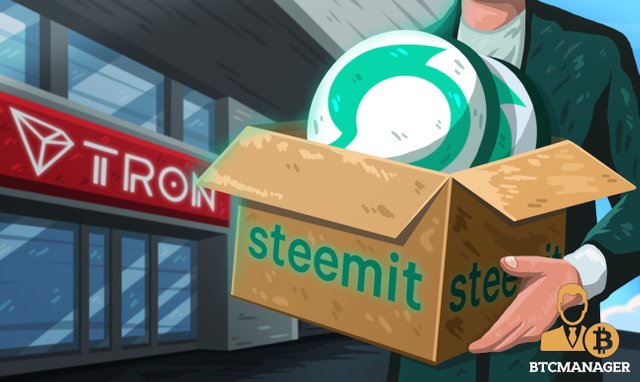
My home work link
Prof this is my homework
https://steemit.com/hive-108451/@blayforson/crypto-academy-season-3-beginners-course-task-1-steem-and-tron-by-blayforson
Here is my entry Prof @sapwood,
https://steemit.com/hive-108451/@paakow/cryptoacademy-season-3-beginner-s-course-homework-post-for-task-1-steem-and-trons-by-paakow
Thank you professor @sapwood for the lecture. It's really an eye opener.
Below is the link to my homework.
https://steemit.com/hive-108451/@msquaretk/crypto-academy-season-3-beginners-course-task-1-steem-and-tron-or-homework-post-for-professor-sapwood
Thanks.
This is my entry,
https://steemit.com/hive-108451/@nishadi89/crypto-academy-season-3-beginners-course-task-1-steem-and-tron
Wow!.... nice lecture Thank you sir
@sapwood here is my home work link
https://steemit.com/hive-108451/@ruthjoe/crypto-academy-season-3-beginners-course-homework-post-for-professor-sapwood-for-task-1-steem-and-tron-by-ruthjoe